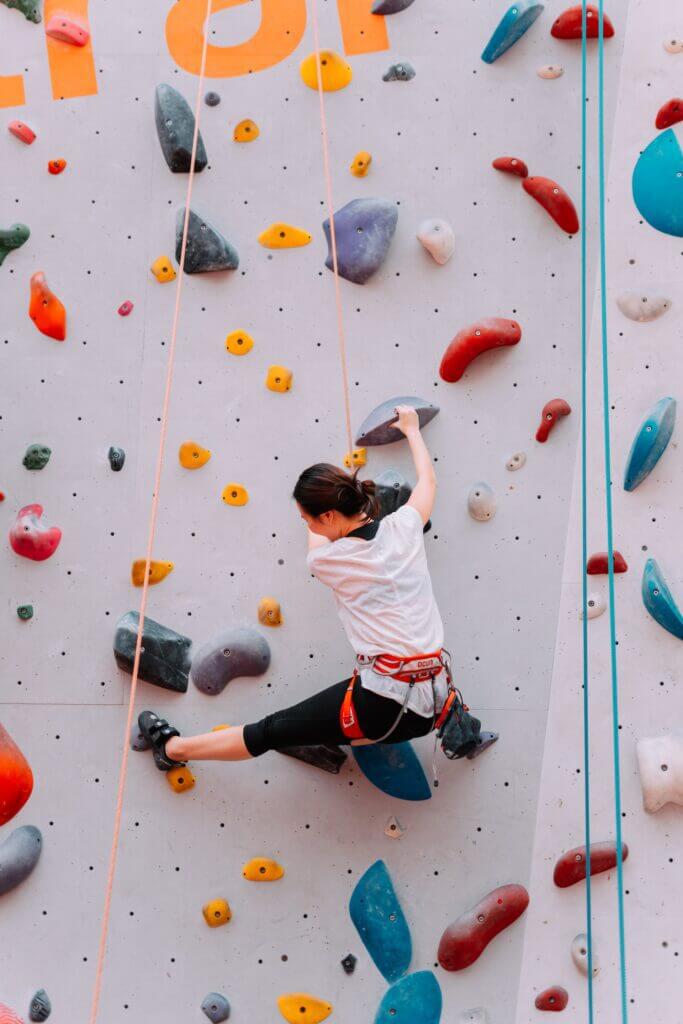During my rock guiding work outdoors, I obsess over selecting an outfit perfect for the day’s objective and weather. Similarly, I provide a lot of guidance to my clients about what to wear while rock climbing.
But one of the reasons I love climbing indoors so much is that I can wear practically anything while doing it. For example, my go-to outfit for a session at the gym is a pair of regular shorts and a cotton t-shirt. But, depending on the season and the indoor climate, I prefer pants and maybe a light sweater.
Dressing for indoor rock climbing is pretty simple. Nonetheless, there are some considerations to make before you go. So, keep reading for some recommendations for what to wear while rock climbing.
What to Wear for Indoor Rock Climbing
Ultimately– you can wear whatever you please when you go rock climbing indoors. However, some clothing is indeed better than others. So, when thinking about what to wear for indoor rock climbing, I recommend you consider the following.
Flexibility and Mobility
You don’t want your clothing to inhibit your flexibility and mobility. In other words, you want your clothing to move with you and not against you.
Flexible and form-fitting clothing that doesn’t inhibit your mobility is ideal because climbing requires acrobatic and gymnastic-like movements such as stretching, stepping, reaching, jumping, crouching, lunging, and squatting.
Lightweight and Breathable
Your clothing should be lightweight and comfortable. Lightweight clothing tends to be more breathable. And breathability is important for temperature control and ventilation.
For example, imagine climbing in a thick wool turtleneck. Are you sweating? Because I am.
Now imagine climbing in a lightweight, cotton, or synthetic textile t-shirt. That feels better, right?
The same goes for your bottom layers. Again, lightweight and flexible shorts or pants are recommended over anything heavy, baggy, or thick and heavy.
Comfortable and Confidence Inspiring
Above all else is– comfort. Climbing gyms, and the climbing community in general, can be wonderful and welcoming spaces that want you to feel comfortable.
So, remember, wear whatever clothing makes you feel comfortable and inspires your confidence.
What About Footwear? Climbing Shoes Are Advised
Climbing gyms are like bowling alleys. They prefer, and you perform better when you wear the appropriate footwear, which in this case, is climbing shoes.
If you are new to climbing and don’t have climbing shoes, no worries. Most climbing gyms have shoes you can rent for a small fee. Climbing shoes are designed to give you more grip when you step on large climbing holds. And they enhance your ability to step on tiny edges.
However, you don’t have to wear your climbing shoes for the entire session. It’s common for climbers to take off their shoes and wear comfier sandals or street shoes when their feet become uncomfortable.
This is also the best practice for going to the bathroom so your climbing shoes don’t spread germs from the bathroom onto the climbing routes.
And if you own climbing shoes, we still recommend taking them off when you’re not climbing to preserve the rubber for longer.

Accessories and Other Gear for Indoor Climbing
In terms of accessories, think simple. Essentially, you want to eliminate the risk of anything falling off you and becoming a hazard for people below.
Besides climbing shoes, the only other gear you need boulder indoors is a chalk bag. However, you will need a harness if you plan to climb on ropes or auto-belays. In most gyms, you can rent harnesses for a small fee.
Other accessories, like gloves, hats, or scarves, are unnecessary. Hats can fall off, gloves inhibit your ability to grip the holds, and scarves can become tangled.
However, I do recommend bringing a water bottle and some snacks. These items don’t come up the wall with you, but they are nice to have because climbing is a workout!
What You Should Avoid While Climbing Indoors
I am not your parent, so I cannot tell you what not to wear. However, I want to make a few recommendations about what to avoid when climbing indoors for safety’s sake.
- Avoid dangling clothing. Dangling objects can get stuck on the route or affect the functionality of your belay device.
- Avoid overly voluminous clothing. Large skirts or dresses can impact how your harness fits and affects your climbing partner’s ability to double-check your equipment.
- Avoid climbing with items in your pockets. For example, cell phones can fall out and become a hazard.
- Avoid short shorts. Overly short shorts provide a ton of flexibility. However, they can bunch up from your harness’ leg loops and become uncomfortable.
- Avoid climbing with your hair down. If you have long hair, wearing it up in a ponytail or something similar is recommended so it cannot obstruct your vision while climbing or get stuck in your belay device.
FAQs About What to Wear When Climbing Indoors
Can I wear socks?
Yes, you can wear socks when you wear rock climbing shoes. This is particularly popular for those who rent climbing shoes from the gym. However, most climbers who own shoes do not wear socks when they climb.
What shoes do I need to bring?
When you go rock climbing indoors, wear comfortable shoes or sandals and change into rock climbing shoes once you get there. Then, in between routes or boulder problems, you can switch back into street shoes or sandals to be more comfortable or for going to the bathroom.
Can I wear jeans while rock climbing?
You sure can! Many people wear denim jeans when they go rock climbing. However, just understand that denim jeans may not be the most lightweight, breathable, and flexible choice.
Should I wear gloves rock climbing?
No, it is unnecessary to wear gloves while rock climbing. Gloves inhibit sensitivity and the surface contact friction between your hands and the holds.
However, gloves are popular for belaying. Belay gloves protect your hands and can provide more control over the rope.
Similarly, some climbers will wear specifically designed crack gloves for crack climbing. Crack gloves protect your hands and provide extra grip between the inside of the crack and the backs of your hands.


